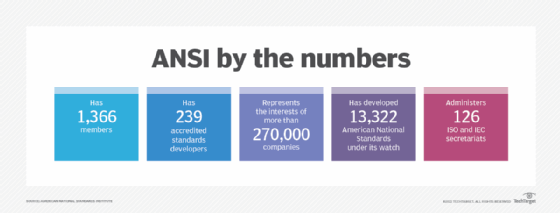ANSI (American National Standards Institute)
What is ANSI?
ANSI (American National Standards Institute) is the main organization supporting the development of technology standards in the United States. ANSI works with industry groups, and it is the U.S. member of the International Organization for Standardization (ISO) and the International Electrotechnical Commission (IEC).
ANSI oversees work on several long-established computer standards, including the American Standard Code for Information Interchange (ASCII) and the Small Computer System Interface (SCSI).
What does ANSI do?
ANSI is a private, nonprofit organization. Its primary goal is to identify and support development of standards in collaboration with industry and government stakeholders. ANSI's various functions include the following:
- American National Standards. ANSI's primary objective is to develop American National Standards. ANSI does this by reviewing and approving the procedures that standards organizations use for developing standards, and by affirming that the completed standards conform to its American National Standards requirements.
- International standards. ANSI is the standards body representing the U.S. at the ISO and the IEC, which set key international standards.
- International trade and development. ANSI is active in a number of public- and private-sector partnerships across the globe that help emerging economies build capacity and pursue other efforts in the areas of standards, trade, infrastructure and regulatory compliance and practices. The Institute also provides resources and assistance to members on international trade and competitiveness issues affecting their business.
- Standards coordination. ANSI coordinates the work of U.S. standards organizations in fields vital to the country's interests. It often does this in new and emerging technology sectors. ANSI engages in ongoing standards collaboration and partnerships. It also holds workshops and other meetings to address specific standards issues. The organization relies on volunteer experts who look for gaps in existing standards, conduct conformity assessments and recommend future projects.
- Membership. ANSI membership is open to any organization that is a stakeholder in the standards specification processes. These include the following:
- companies;
- government agencies;
- educational institutions; and
- other organizations, including nonprofits and consumer and trade associations.
Member organizations gain access to the Institute's standards communities and the opportunity to participate in or otherwise affect standards processes.
ANSI does not create or publish standards itself, but it does approve standards that other organizations develop and publish as American National Standards.

Why is ANSI important?
ANSI helps enable the development of international standards for all aspect of modern life. When manufacturers worldwide comply with the same set of standards, people and organizations are empowered to expect standardized experiences and products related to almost every activity of daily life.
Without standards, making products and services interoperate globally would become difficult:
- Standards enable the use of standard-sized shipping containers, which enable faster and more economical shipping.
- Standards enable interoperability on the internet. The same computer can be plugged into a network anywhere in the world and be capable of interoperating with any system anywhere else in the world.
ANSI's role is to help foster participation of U.S. standards organizations in their global communities of consumers, businesses and other interested parties.
What is JTC 1?
ANSI serves as the secretariat for the ISO/IEC Joint Technical Committee on Information Technology (IT), which is also called the JTC 1. It works on IT and communications standards in the following areas:
- Design and development
- Performance and quality
- Security
- Application portability
- Interoperability
- Unified tools and environments
- Consistent vocabulary
- User-friendly and ergonomic user interfaces
History of the American National Standards Institute
ANSI's organization, functions and roles have evolved over the years. Its evolution reflects changes in the global standards environment, which has evolved to improve access to and use of standards.
Some key milestones in ANSI's history include the following.
1918. The American Engineering Standards Committee (AESC) is established as a national organization for coordinating accredited standards development.
1921. AESC approves the first U.S. safety standard for industrial workers, establishing specifications for protecting workers' eyes and heads.
1926. AESC promotes the establishment of the International Federation of the National Standardizing Associations, the organization that eventually became the International ISO.
1928. After a reorganization, the AESC is renamed as the American Standards Association (ASA).
1946. The ASA and standards bodies from 25 other countries form the ISO.
1966. The ASA reforms as the United States of America Standards Institute (USASI).
1969. USASI changes its name to ANSI.
1970. ANSI creates a public review process and the ANSI Board of Standards Review to apply that process.
1976. A joint coordinating committee is established with ANSI and the Occupational Safety and Health Administration to work on voluntary consensus standards activities related to workplace health and safety.
1982. A joint coordinating committee is established with the U.S. Consumer Product Safety Commission, to focus on ensuring consumer products promote the safety and health of consumers.
1987. ANSI takes responsibility for the JTC 1, which develops standards for information and communications technologies.
2000. ANSI assists with the first U.S. National Standards Strategy. It creates a framework for standard-setting.
ANSI's work on standards shows up everywhere -- especially in data and networking. Find out more about the ANSI/TIA-942 standard for data center requirements or the ISA-95 standard for software interfaces between enterprises and their control systems, another standard developed in cooperation with ANSI.







